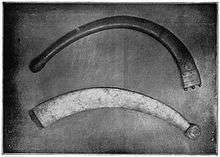Valari
A valari (Tamil: வளரி) is a thrown wooden or iron weapon used primarily by the Tamil people of the Indian subcontinent.[1] They come in both returning and non-returning varieties. The valari is used for protecting cattle from predators, and for war and hunting. Valaris are described in the Tamil Sangam Purananuru.
| Valari | |
|---|---|
 | |
| Type | Throwing |
| Place of origin | Tamil Nadu, India |
| Service history | |
| Used by | Tamils |
Construction
Similar to the hunting boomerang of the aboriginal Australians, some valari also return to the thrower. Returning boomerangs used for sport have special aerodynamics to enable their return, while hunting boomerangs are designed to fly straight or slightly curved to hit a target.
Valaris are made in many shapes and sizes. The usual form consists of two limbs set at an angle; one thin and tapering, the other rounded to form a handle. Valaris are usually made of iron cast in moulds, although some may have wooden limbs tipped with iron or have lethally sharpened edges.
Use
The thrower holds the valari by one of its limbs and throws it. There are several ways of throwing and aiming. It is usually given a spin while throwing. While flying through the air, it can maneuver and execute several types of movements according to the throwers purpose. It may spin in the vertical axis, horizontal axis, or just fly without spinning. The spin may also vary in speed. A lethal throw is given a spin and aimed at the neck. A non-lethal throw is given a spin and aimed at the ankles or knees. This is to capture a fleeing victim. A simple hurting blow does not have any spin. It is sharp enough to cut through a person's neck during war.
It is mostly used once for wars and hunting by the people of Tamil Nadu, known as Kallar and Maravar people. The English destroyed most of the valaris when they came for conquest as they thought it would be a potential weapon of war. Only a handful of valaris are left in Tamil Nadu now.
References
- Thurston, Edgar (2001) [First printed in 1909 by Madras Government Press]. "Kallan". Castes and Tribes of Southern India. III (Fourth AES reprint ed.). New Delhi: J. Jetley. p. 70. ISBN 978-81-206-0288-5. Retrieved 8 January 2013.